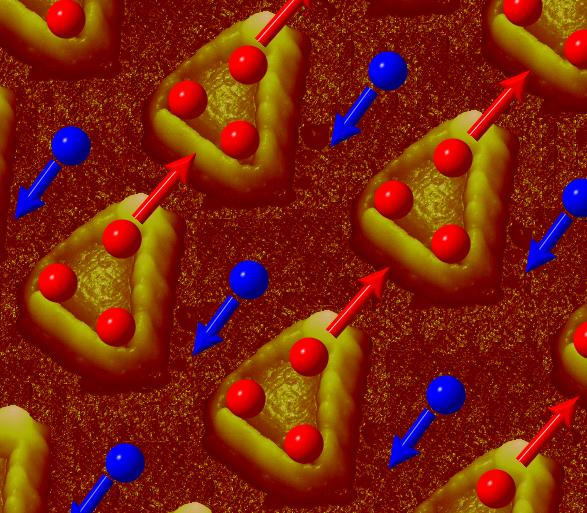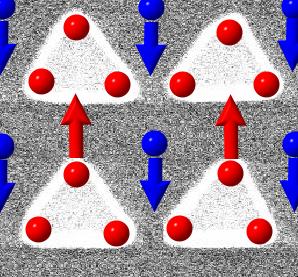Reversible Rectifier that Controls the Motion of Magnetic Flux Quanta in Superconductors
Science 302, 1188 (Nov. 14, 2003).
See also perspectives in Science 302, 1159 by H. Hilgenkamp, V. V. Moshchalkov, P. Kes; and Highlight: Science 302, 1111.
J.E. Villegas (1), Sergey Savel’ev (2), Franco Nori (2,3), E.M. Gonzalez (1), J.V. Anguita (4), R. García (4), J.L. Vicent(1)
1 Departamento de Física de Materiales,
Facultad Ciencias Físicas, Universidad Complutense, Madrid,
Spain.
2 Frontier Research System, The Institute
of Physical and Chemical Research (RIKEN), Wako-shi, Saitama,
Japan.
3 Center for Theoretical Physics, Department
of Physics, University of Michigan, Ann Arbor, MI, USA.
4 Instituto de Microelectrónica
de Madrid, Centro Nacional Mícroelectrónica, Consejo Superior
de Investigaciones Científicas, Madrid, Spain.
Abstract
We fabricated a device that controls the motion of flux
quanta in a Niobium superconducting film grown on an array of nanoscale
triangular pinning potentials. The controllable rectification of the vortex
motion is due to the asymmetry of the fabricated magnetic pinning centers.
The reversal in the direction of the vortex flow is explained by the interaction
between the vortices trapped on the magnetic nanostructures and the interstitial
vortices. The applied magnetic field and input current strength can tune
both the polarity and magnitude of the rectified vortex flow. Our ratchet
system is explained and modeled theoretically considering the interactions
between particles.


Schematics of vortex motion interacting with nano-magnetic triangles.
Introduction
Motor proteins play a key role in the transport of materials
at the cellular level. These biological motors are anisotropic devices
that, driven by non-equilibrium fluctuations, bias the motion of particles,
and are inspiring a new generation of solid-state devices that open new
avenues for controlling the motion of, for example, electrons, colloidal
particles, and magnetic flux quanta.
We consider superconducting devices
with anisotropic pinning, where the dc transport of magnetic flux quanta
may be driven by an ac or unbiased current. The control of the motion of
vortices using asymmetric pinning can be useful for applications in superconductivity,
including field-dependent reversible vortex diodes and the removal of unwanted
trapped flux in devices. Several different ways of using asymmetric pinning
in superconductors to control vortex motion have been recently proposed.
However experiments in this area have been difficult to control.
Our device allows a versatile control of the motion of vortices in superconducting films. Simple modifications and extensions of it would allow the pile up (magnetic “lensing”), shaping, or “sculpting” of micro-magnetic profiles inside superconductors. Thus, vortex lenses made of oppositely-oriented triangles would provide a strong local increase of the vortex density at its “focus” regions. Thus, extensions of these type of systems should open new avenues for motion control of flux quanta and provide a first step towards a new generation of devices based on the flow of magnetic flux quanta.
Importance
As integrated circuits become smaller and smaller, it becomes increasingly difficult to create the many "guiding channels" that act like wires to move electrons around the circuit components.
This difficulty in wiring nano-circuits must be overcome if researchers are to continue developing the microscopic machines and sensors that represent the wave of the future in nanotechnology. It is important to control the motion of magnetic field lines within the superconducting material, so that their motion does not produce noise that degrades the performance of devices. A new approach and several novel devices proposed by our group offer possible sikutions to these problems.
Magnetic fields penetrate superconducting materials via lattices of quantized magnetic flux, called vortices because electrons whirl around them without dissipating energy. Electrical currents, externally applied to superconducting devices, induce the motion of these magnetic flux quanta. This vortex motion produces noise that degrades the device performance in practical applications, such as the sensitive measuring of the magnetic fields produced by the brain. Therefore, the precise control of the motion of these vortices is of central importance for applications involving superconducting materials.
By controlling the motion of quanta inside superconducting materials, the new devices allow the design of micro-machines such as "pumps," "diodes" and "lenses" of magnetic flux quanta to create specific magnetic profiles within a given sample or device. This would give designers the ability to remove unwanted flux trapped inside superconducting devices and enable researchers to increase the magnetic field in designated target regions inside materials, which would "magnetically focus" nearby magnetic particles.